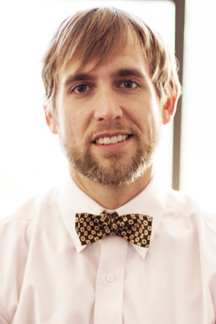Technology Meets Teamwork: Andrew Ward Unlocks Viruses' Secrets
By Madeline McCurry-Schmidt
In his office at The Scripps Research Institute (TSRI), Associate Professor Andrew Ward pulls up an image of a viral protein. Two hundred years ago, no scientist had ever heard of a viral protein—or even a virus. Three hundred years ago, diseases caused by viruses were blamed on bad humors or even witchcraft.
Yet here’s a critical component of a virus on the computer screen, tinted light blue, each little bump of its structure gleaming.
“With most of the things we’re looking at, we’re the first set of eyes to ever see it,” Ward says.
Ward’s goal is to figure out the 3-D structures of proteins from microscopic organisms that cause disease, revealing weak spots that might be targeted with vaccines and drugs. Since starting his lab at TSRI in 2010, Ward has discovered new aspects of viruses including HIV, influenza and Ebola virus.
Ward credits the environment at TSRI for this success. “The access to collaborators and technology is like nowhere else,” said Ward. “It’s a continuing education.”
Building a Career
Ward’s career in science started when he was an undergraduate at Duke University with a job dissecting insects. The lab focused on muscle physiology and gave Ward an appreciation for how microscopic elements, like insect muscle filaments, underlie all biological structures.
After graduation, Ward’s mentors at Duke arranged for him to work as a technician in the lab of Professor Ron Milligan at TSRI.
Milligan has long pushed the limits of a technique called electron microscopy (EM), where a sample is pelted with high-energy electrons. The high-energy electrons excite electrons in the sample, allowing scientists to construct images. Scientists put these images together to build a 3-D structure.
When Ward arrived, Milligan and his colleagues at TSRI were perfecting a kind of EM called cyro-electron microscopy (cryoEM), in which samples are frozen with liquid nitrogen to enable even clearer images. The researchers were combining cryoEM with new programs for automated imaging developed at TSRI—computer programs that could locate the most promising parts of a sample and take images more quickly than a human could, and with more endurance.
“That was really at the beginning of high-resolution cryo microscopy,” said Ward.
Ward ended up working on independent research projects and decided to enroll in TSRI’s graduate program. As a graduate student, he expanded his work to include protein biochemistry and x-ray crystallography, a different high-resolution imaging technique.
Both as a student and more recently as a faculty member, Ward credits the lack of barriers at TSRI for letting him move between labs and learn new techniques.
“That really prevents you from getting stuck and focusing too narrowly on a project,” said Ward. “Within five minutes, you’re in any lab doing anything you want to do.”
Finding New Treatments
Ward is working with a unique toolbox.
In the last two years, two new microscopes, the Titan Krios and the Talos TEM, arrived at TSRI, thanks to funding from TSRI, the National Institute of Allergy and Infectious Diseases at the NIH, and the Bill & Melinda Gates Foundation. The microscopes take up entire rooms in TSRI’s dedicated EM suite and offer a new generation of technology that captures images at an even higher resolution.
“There are only about 10 labs or so in the world that are doing what we’re doing, in terms of atomic-resolution cryo microscopy, and we’re doing it at higher throughput because of the automation we have at Scripps, the infrastructure and supercomputing—and the expertise,” said Ward.
Among those experts are Dennis Burton and Ian Wilson, who are working to find antibodies that can neutralize HIV. Burton is chair of the Department of Immunology and Microbial Science, scientific director of the International AIDS Vaccine Initiative’s (IAVI) Neutralizing Antibody Consortium, and the National Institutes of Health-sponsored Center for HIV/AIDS Vaccine Immunology and Immunogen Discovery (CHAVI-ID) at TSRI. Wilson is Hansen Professor of Structural Biology at TSRI and chair of the Department of Integrative Structural and Computational Biology.
In 2014, Ward’s work with Burton and Wilson resulted in a pair of papers published in the journal Immunity, showing a new vulnerable site on HIV that could be attacked by human antibodies and thus potentially targeted in a vaccine. The Ward lab’s 3-D structures showed that this site was only present in the mature form of HIV when three proteins intertwined to form a “trimer.”
“My lab members and I were the first people to ever see the HIV trimer structure, which was really exciting,” said Ward. “If you can target these particular viral proteins, then in theory, you can actually kill the virus.”
Ward was recently awarded two grants from the Gates Foundation to advance efforts to collect and process high-resolution images of such HIV proteins interacting with antibodies, so that the scientists can better evaluate vaccine candidates.
Recent studies in Ward’s lab have also focused on finding vulnerable spots in Ebola virus. He’s currently working with TSRI Professor Erica Ollmann Saphire to study antibodies against Ebola virus sent from labs around the world.
Ward’s favorite part of the job is the diversity of his projects. He doesn’t think he will never run out of new structures to image and examine. After all, there are an estimated 30,000 different proteins in human cells alone, and proteins can assemble into an even larger number of complexes and macromolecular machines that have unique structures.
“I think it’s really a personality thing,” said Ward. “I wanted to never be bored in life.”
Send comments to: press[at]scripps.edu















